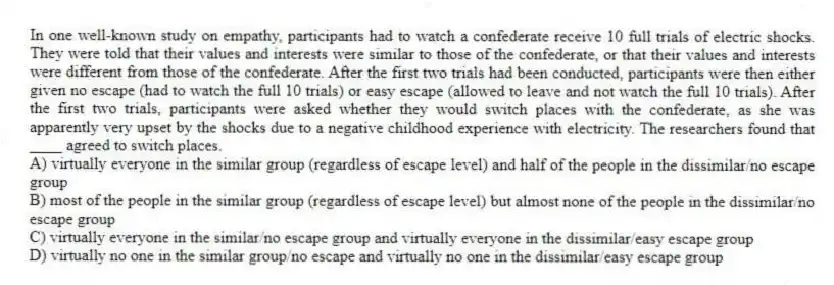
In one well-known study on empathy, participants had to watch a confederate receive 10 full trials of electric shocks. They were told that their values and interests were similar to those of the confederate, or that their values and interests were different from those of the confederate. After the first two trials had been conducted, participants were then either given no escape (had to watch the full 10 trials) or easy escape (allowed to leave and not watch the full 10 trials) . After the first two trials, participants were asked whether they would switch places with the confederate, as she was apparently very upset by the shocks due to a negative childhood experience with electricity. The researchers found that ____ agreed to switch places.
A) virtually everyone in the similar group (regardless of escape level) and half of the people in the dissimilar/no escape group
B) most of the people in the similar group (regardless of escape level) but almost none of the people in the dissimilar/no escape group
C) virtually everyone in the similar/no escape group and virtually everyone in the dissimilar/easy escape group
D) virtually no one in the similar group/no escape and virtually no one in the dissimilar/easy escape group
Correct Answer:
Verified
Q110: As discussed in the text, social psychologists
Q111: Research on who helps whom indicates that
Q112: In one well-known study on empathy, participants
Q112: Research on gender and helping indicates that
Q113: The notion that feeling another's pain motivates
Q114: In general, when it comes to helping
Q116: In one well-known study on empathy, participants
Q118: Being able to feel another person's pain
Q119: Much of the time, people engage in
Q119: In general, in which of the following
Unlock this Answer For Free Now!
View this answer and more for free by performing one of the following actions

Scan the QR code to install the App and get 2 free unlocks

Unlock quizzes for free by uploading documents